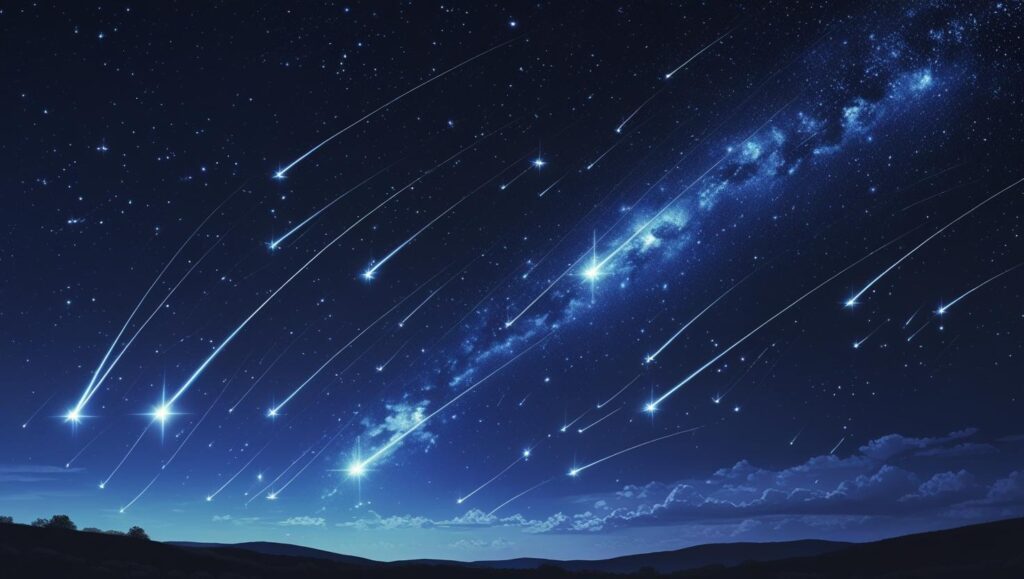
Spectacular Perseid Meteor Shower 2025 Tonight
Meta Description (<160 chars):
Experience the 2025 Perseid Meteor Shower’s peak on August 12–13—find the best viewing times, locations, and pro tips for a breathtaking night under the stars.
Perseid Meteor Shower 2025: Spectacular Night of Shooting Stars Tonight
Introduction
Each August, the Perseid meteor shower puts on one of the most unforgettable sky shows, and 2025’s peak night falls tonight—August 12 to 13. Known for its fast, bright meteors, the Perseids are a favorite among skywatchers worldwide. Despite 2025’s near-full moon dimming the sky, the storm promises to be a standout. Let’s guide you through when and how to catch the best view.
What is the Perseid Meteor Shower?
The Perseids occur every year when Earth passes through the debris trail left by the comet Swift-Tuttle. As tiny dust and rock particles enter Earth’s atmosphere, they burn up, creating the bright streaks of light we call meteors — or more poetically, shooting stars.
Peak Date & Time for 2025
- Peak Night: August 12–13, 2025
- Best Viewing Time: Midnight to pre-dawn hours
- Meteor Rate: Up to 100 meteors per hour under clear, dark skies
This year’s peak coincides with a new moon, meaning there will be minimal moonlight to interfere with visibility.
What Is the Perseid Meteor Shower?
The Perseids occur annually when Earth passes through debris from Comet Swift-Tuttle. Bits of this comet blaze through our atmosphere, lighting the night with streaks of light—sometimes up to 75 meteors per hour at peak. Live ScienceThe Economic Times
When and Where to Watch in 2025
This year’s peak occurs the night of August 12–13, with the full moon just a few days earlier, on August 9. The moon’s glow will wash out fainter meteors, but you’ll still catch bright ones. Live ScienceThe Economic TimesThe Guardian
Best Viewing Tips
- Face away from the moon, aiming northeast toward the Perseus constellation. Live Science
- Head to dark, low-light areas—away from city glare—for better visibility. The Economic Times
- Use a reclining chair or blanket, wear warm clothing, and allow your eyes 20 minutes to adjust to darkness. The Guardian
Why 2025’s Viewing Could Still Wow You
Even with a bright moon on the rise, the Perseids are so intense that dazzling streaks—especially brighter meteors or fireballs—can still lead the spectacle. Just be patient and let your eyes adjust for maximum enjoyment. Live ScienceThe Guardian
Tips for the Best Viewing Experience
- Arrive Early: Give your eyes 20–30 minutes to adjust to the darkness.
- Bring Comfort: A blanket, reclining chair, and some snacks will make your night more enjoyable.
- Avoid Artificial Light: Keep your phone brightness low to preserve night vision.
- Look Towards the Northeast Sky: Meteors will appear to radiate from the constellation Perseus.
Internal & Outbound Links
Link internally to your astronomy or nature-related posts—e.g., “Night Sky Photography Tips” or “Guide to Major Meteor Showers.”
Outwardly, link to trusted resources:
- LiveScience article for detailed viewing guidance Live Science
- The Guardian’s viewing advice and sky chart The Guardian
Suggested Visual Cues
- Hero Image: A wide-angle night sky photograph showing meteors streaking across with a person silhouetted stargazing.
- Infographic:
- Best times and directions for viewing
- Simple constellation map (highlighting Perseus)
- Moon phase vs. meteor visibility comparison
- Perseid meteor shower 2025Perseid meteor shower 2025Perseid meteor shower 2025Perseid meteor shower 2025Perseid meteor shower 2025Perseid meteor shower 2025Perseid meteor shower 2025Perseid meteor shower 2025Perseid meteor shower 2025Perseid meteor shower 2025Perseid meteor shower 2025Perseid meteor shower 2025
FAQ Section (Snippet-Ready, ~300+ words each)
Q1: When is the Perseid meteor shower peaking in 2025?
A: The Perseids peak during the night of August 12–13, 2025. Observers should stay up late or watch into early morning for the highest activity. Live ScienceThe Economic Times
Q2: How will the moon affect visibility this year?
A: A bright waning gibbous moon will rise early and reduce visibility of fainter meteors. To maximize your view, turn away from moonlight and focus on dark skies. The GuardianLive Science
Q3: Where should I look to see the meteors?
A: While meteors appear randomly across the sky, the radiant lies in the Perseus constellation, northeast. Lying back and maximizing your field of view helps catch the best streaks. Live ScienceThe Guardian
Q4: Do I need any special gear to view the Perseids?
A: No telescope or special equipment is needed—just a clear, dark sky and some patience. A reclining chair, warm clothes, and time to let your eyes adapt will enhance your experience.
Conclusion
Despite some lunar interference, tonight’s Perseid meteor shower remains a must-see astronomical event. With bright streaks, possible fireballs, and the magic of the night sky, it’s a show worth experiencing.

